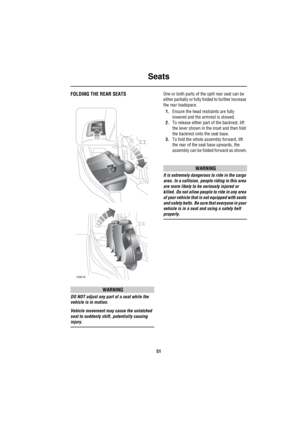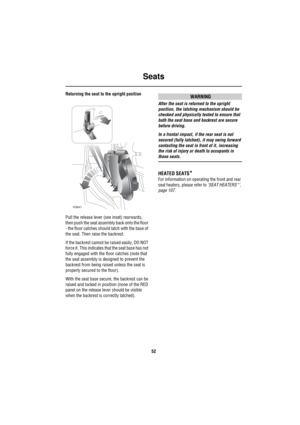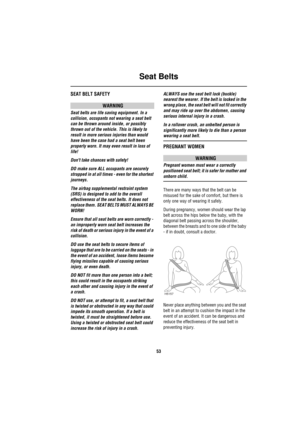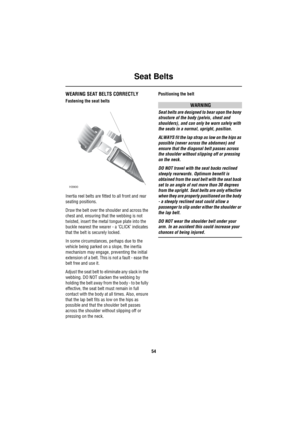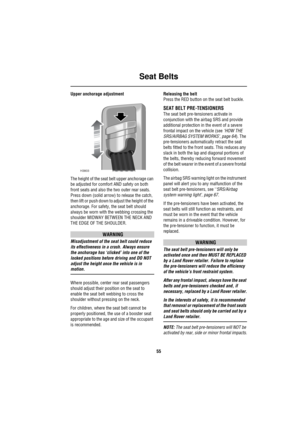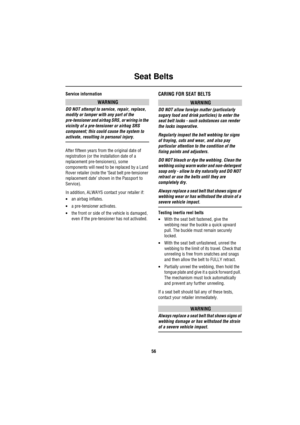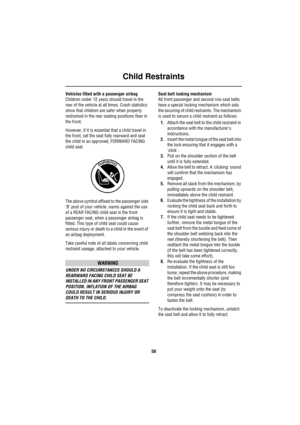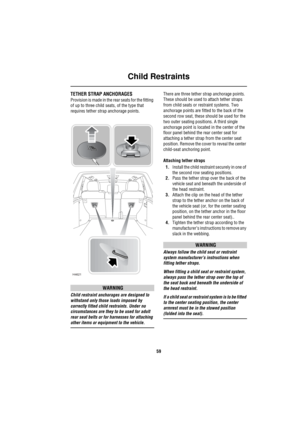Home
>
Land Rover
>
Automobile
>
Land Rover Range Rover 2004my Owners Handbook Lm 2nd Edition Nas Rover
Land Rover Range Rover 2004my Owners Handbook Lm 2nd Edition Nas Rover
Here you can view all the pages of manual Land Rover Range Rover 2004my Owners Handbook Lm 2nd Edition Nas Rover. The Land Rover manuals for Automobile are available online for free. You can easily download all the documents as PDF.
Page 51
Seats 50 Setting the memory pre-sets Adjust the seat, exterior mirrors and the steering column to the desired position. Press the memory store button (1) to activate the memory function (switch indicator light illuminates), then press the desired pre-set button (2) to store a seat/mirror/steering wheel setting. A second press of the button (before pressing a pre-set) cancels the memory function (light extinguishes). If a pre-set is not pressed within approximately 7 seconds of the memory...
Page 52
Seats 51 FOLDING THE REAR SEATS WARNING DO NOT adjust any part of a seat while the vehicle is in motion. Vehicle movement may cause the unlatched seat to suddenly shift, potentially causing injury.One or both parts of the split rear seat can be either partially or fully folded to further increase the rear loadspace. 1.Ensure the head restraints are fully lowered and the armrest is stowed. 2.To release either part of the backrest, lift the lever shown in the inset and then fold the backrest onto...
Page 53
Seats 52 Returning the seat to the upright position Pull the release lever (see inset) rearwards, then push the seat assembly back onto the floor - the floor catches should latch with the base of the seat. Then raise the backrest. If the backrest cannot be raised easily, DO NOT force it. This indicates that the seat base has not fully engaged with the floor catches (note that the seat assembly is designed to prevent the backrest from being raised unless the seat is properly secured to the...
Page 54
Seat Belts 53 Seat BeltsSEAT BELT SAFETY WARNING Seat belts are life saving equipment. In a collision, occupants not wearing a seat belt can be thrown around inside, or possibly thrown out of the vehicle. This is likely to result in more serious injuries than would have been the case had a seat belt been properly worn. It may even result in loss of life! Dont take chances with safety! DO make sure ALL occupants are securely strapped in at all times - even for the shortest journeys. The airbag...
Page 55
Seat Belts 54 WEARING SEAT BELTS CORRECTLY Fastening the seat belts Inertia reel belts are fitted to all front and rear seating positions. Draw the belt over the shoulder and across the chest and, ensuring that the webbing is not twisted, insert the metal tongue plate into the buckle nearest the wearer - a ‘CLICK’ indicates that the belt is securely locked. In some circumstances, perhaps due to the vehicle being parked on a slope, the inertia mechanism may engage, preventing the initial extension...
Page 56
Seat Belts 55 Upper anchorage adjustment The height of the seat belt upper anchorage can be adjusted for comfort AND safety on both front seats and also the two outer rear seats. Press down (solid arrow) to release the catch, then lift or push down to adjust the height of the anchorage. For safety, the seat belt should always be worn with the webbing crossing the shoulder MIDWAY BETWEEN THE NECK AND THE EDGE OF THE SHOULDER. WARNING Misadjustment of the seat belt could reduce its effectiveness...
Page 57
Seat Belts 56 Service information WARNING DO NOT attempt to service, repair, replace, modify or tamper with any part of the pre-tensioner and airbag SRS, or wiring in the vicinity of a pre-tensioner or airbag SRS component; this could cause the system to activate, resulting in personal injury. After fifteen years from the original date of registration (or the installation date of a replacement pre-tensioners), some components will need to be replaced by a Land Rover retailer (note the ‘Seat belt...
Page 58
Child Restraints 57 Child RestraintsCHILD RESTRAINTS FOR SMALL CHILDREN AND BABIES Infants and children too small for adult seat belts should be restrained in a child safety seat or restraint system appropriate to their age and/or size, and which is approved for use in your vehicle. Child seats and restraint systems designed for your vehicle will be one of two types: •Those secured in vehicle seats by lap belts (or the lap belt portion of a lap/shoulder belt), •‘LATCH’ type child restraints...
Page 59
Child Restraints 58 Vehicles fitted with a passenger airbag Children under 12 years should travel in the rear of the vehicle at all times. Crash statistics show that children are safer when properly restrained in the rear seating positions than in the front. However, if it is essential that a child travel in the front, set the seat fully rearward and seat the child in an approved, FORWARD FACING child seat. The above symbol affixed to the passenger side ‘B’ post of your vehicle, warns against...
Page 60
Child Restraints 59 TETHER STRAP ANCHORAGES Provision is made in the rear seats for the fitting of up to three child seats, of the type that requires tether strap anchorage points. WARNING Child restraint anchorages are designed to withstand only those loads imposed by correctly fitted child restraints. Under no circumstances are they to be used for adult rear seat belts or for harnesses for attaching other items or equipment to the vehicle.There are three tether strap anchorage points. These...

